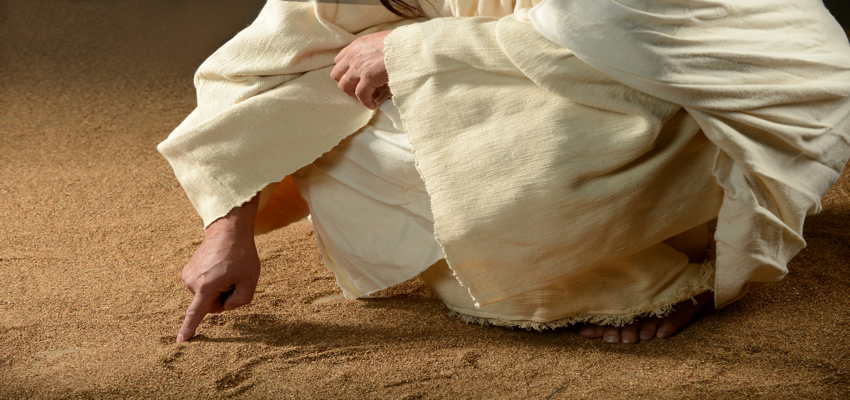|
John 8:1-11 (NRSVCE) Jesus went to the Mount of Olives. Early in the morning he came again to the temple. All the people came to him and he sat down and began to teach them. The scribes and the Pharisees brought a woman who had been caught in adultery; and making her stand before all of them, they said to him, “Teacher, this woman was caught in the very act of committing adultery. Now in the law Moses commanded us to stone such women. Now what do you say?” They said this to test him, so that they might have some charge to bring against him. Jesus bent down and wrote with his finger on the ground. When they kept on questioning him, he straightened up and said to them, “Let anyone among you who is without sin be the first to throw a stone at her.” And once again he bent down and wrote on the ground. When they heard it, they went away, one by one, beginning with the elders; and Jesus was left alone with the woman standing before him. Jesus straightened up and said to her, “Woman, where are they? Has no one condemned you?” She said, “No one, sir.” And Jesus said, “Neither do I condemn you. Go your way, and from now on do not sin again.” It’s a peculiar scene John has painted for us here. The Pharisees bring a woman to Jesus, informing him that she is an adulterer. And rather than respond to the charges, or question the woman, Jesus begins writing on the ground with his finger. He continues to write, while they continue to demand he pronounce judgment. He then utters the phrase we are probably all quite familiar with: “Let anyone among you who is without sin be the first to throw a stone at her.” Then he continues writing, and they leave. It’s only after they leave that Jesus tells the woman “Go and sin no more.”
This story leaves us with a lot of questions. First of which is “What is Jesus writing?” John is silent on the content, but he makes sure to mention the action twice, so it seems there’s some relevance to it. It’s possible that Jesus was simply doing the sort of task we all do while idle, or while bored. Doodling, essentially. It could be he used that kind of action to defuse the situation. The Pharisees came rushing up to him, hopping mad, and repeatedly demanded that Jesus proclaim judgment on whether or not they should stone this woman. Approaching someone in that kind of a rage only to be met with indifferent doodling would probably catch them off guard, and perhaps lower the air of anger amongst them. But is there more to it than that? Was it just a tactic, a psychological game Jesus was playing with them? Or is the actual content of Jesus’ doodles relevant? The Church Fathers seemed to think so. St. Jerome opined, in Against the Pelagians, that what Jesus was writing was, in fact, the sins of the woman’s accusers. They were laying her sin bare before everyone, demanding punishment. Those who are quick to point out others’ sins are often the best at hiding their own. But nothing can be hidden from Christ, who is the Judge. So while they continue to demand they be allowed to enact retribution on her for her sin, Jesus calmly lays their own sins bare in the sand. Notice how they don’t stop accusing and questioning until after Jesus bends down a second time to write some more. Could it be that they were afraid of the further sins Christ would reveal to the people? The irony in the story is that now the sins of all present have been laid bare, before the only one who can forgive them. It’s only the woman who sticks around for absolution: “Go and sin no more.” The Pharisees flee from this forgiveness. They are too afraid of facing the reality of their sins. If they had stayed and faced their judgment, as the woman did, surely Jesus would have forgiven them as well. But they did not. They were so arrogant in their piety, so good at hiding their sin from the world, that they couldn’t bear to have it revealed. I often wonder who I am in this story. Am I the adulterer, the sinner who nonetheless accepts judgment and receives absolution? Or am I a Pharisee, who flees from forgiveness because I care too much about my reputation? |
ArchivesCategories
All
|

 RSS Feed
RSS Feed